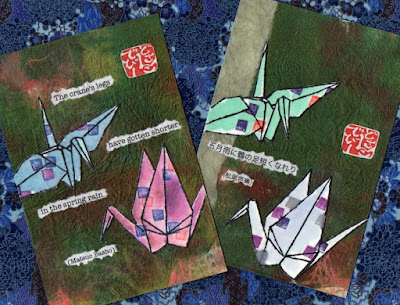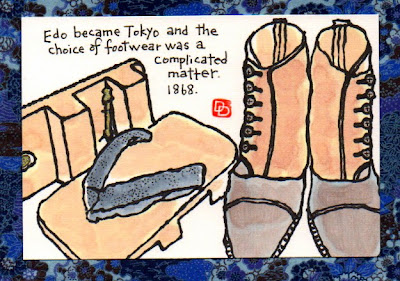Thursday, May 28, 2015
rainy season haiku
While Hokkaido looks forward eagerly to a typically mild, sunny, fragrant, bright green, sweet-breezy June, the rest of Japan has entered-- or is about to enter-- the pre-summer rainy season called tsuyu, often translated literally as "plum rains."
The mugginess of tsuyu can be quite miserable-- one of those times of the year when I wonder out loud how anyone would choose to live anywhere other than tsuyu-less Hokkaido. (In just a few months, the Hokkaido winter will arrive with a powerful reply to that question.)
Well, anyway, I've been working on tsuyu-related etegami to encourage my friends who have to endure the rainy season. I started with a couple of etegami collages that recombine parts of previous etegami that may seem familiar to you.
Both the Japanese version and the English version quote a gently humorous haiku by Matsuo Basho: The crane's legs/have gotten shorter/in the spring rain (translated by Robert Hass). It's easy to imagine the cranes standing in the water, their long, skinny legs appearing shorter and shorter, as the level of the river, stream or lake rises higher and higher. The folded paper cranes, being legless, are kind of perfect for this haiku, don't you think?
Sunday, May 24, 2015
Sunday, May 17, 2015
the gap in the wall
Look what arrived in the mail today! It's a work of textile art (matted but not yet framed) by Polish textile artist Bozena Wojtaszek. I've had my eye on it for a very, very long time. I first saw it on her blog The Textile Cuisine, where she showed it to her readers as a work-in-progress. Then, a week or so ago, I saw it listed on her Etsy shop and I knew that I had to have it.
Her name for it is Old Wall, but I privately call it The Gap in the Wall, because for me it illustrates the Bible passage Ezekiel 22:30: I looked for someone among them who would build up the wall and stand before me in the gap on behalf of the land so I would not have to destroy it, but I found no one.
 And. Guess.What. Bozena enclosed a bonus in the package with the Wall. A precious flowery fiber art card for framing or sending in the mail as a postcard! I am a very happy girl.
And. Guess.What. Bozena enclosed a bonus in the package with the Wall. A precious flowery fiber art card for framing or sending in the mail as a postcard! I am a very happy girl.Monday, May 11, 2015
more candy box mail art
Last month I received a small box of leaf-shaped cakes from Yun, my etegami friend in France. The cakes themselves didn't last long enough to appear in the photo I posted on my received mailart blog, but if you click the link, you can see the empty box and Yun's corrugated cardboard etegami that shows what the cakes looked like.
Even empty, the little box charmed and intrigued me. I had opened it in such a way as to leave the cellophane wrapping mostly undisturbed. So not only did the box look unopened, the diamond-shaped hole appeared to have window glass in it.
I cut out a flat "tray" from corrugated cardboard that slid smoothly in and out of the box, and glued flowery chiyogami (washi craft paper) and my favorite etegami bee images onto the tray. The bees were glued to bits of thick corrugated cardboard to give them a pop-out look. Finally I added words appropriate to the scene, and tucked the finished tray into the box. The part of the tray that you can see through the "window" has enough depth to make it seem like you're peeking into another world. I was planning to send the finished box to Yun, but I'm enjoying it so much that I think I'll keep it for a while. :)
Friday, May 8, 2015
forget the calendar
Furthermore, I certainly don't want my own kids (both of whom I kept close to my side while they were growing up) to express any appreciation they might have for me just because it's "Mother's Day." Although.... if that's the only day I can get any appreciation (assuming I deserve any), I will take it gratefully.
So, back to my own mother. One of the few-but-sweet memories I have of very early childhood is of my mother singing to us kids after she had tucked us in bed. I would sing those same songs softly to myself in later childhood, and even as late as early adulthood, during lonely or desperate nights when I lived far from home among strangers in a land that was strange to me.
Tuesday, May 5, 2015
life in the 19th century (mail art call)
A momentous event happened in mid-19th century Japan. The Tokugawa (Edo) government, which had controlled Japan with an iron hand for 250 years, crashed and gave way to a new government brought about by the Meiji Restoration. The accompanying changes, including a new openness to western culture, must have seemed drastic and strange to the ordinary person at the time. Suddenly, choosing footwear was more complicated than it had ever been before....
I painted this as my submission to an Italy-based mail art call on the theme "Life in the 19th Century," and YOU are invited to participate too. I copied and pasted the following details from the event's Facebook page:
Artists from all over the world are invited to participate in this International Mail Art Project organised by the Faenza’s Watercolourists Association. Everyone is welcome to participate, all ages and skill levels. An exhibition of the received works will have place in Faenza, Italy, during the first days of November 2015 for the yearly St. Rocco fair of the city . All the works will be exhibited online in a special album posted in the event too and later there will be also pictures taken at the exhibition.
Theme: “Life in the XIX century” (years 1800/1899)
Size: Postcard (10 x 15 cm)
Technique: Free (watercolour, painting, drawing, collage and so on)
Rules: No jury, no fees, no return of the works, only original works, no copies. It is up to the artist to send in envelope or not, only 1 piece for each artist.
Deadline: Works must arrive by the 1st of October 2015.
Please clearly indicate name, address and email address on the back of the card.
Send your card to:
Associazione Acquerellisti Faentini
c/o Silvano Drei
Via Portisano 46
48018 Faenza (RA)
Italy
Monday, May 4, 2015
ants for lunch
Ever since a friend asked me to paint her an anteater, I've been having the greatest fun exploring the possibilities of anteater etegami. We should get together soon. I don't mind sharing my ants. Or bring your own lunch, if you prefer.
preserving a heritage with snail mail
After getting interviewed on the Postcrossing blog, I started getting messages from people all over the world who value art postcards-- and snail mail in general-- as much (or more) than I do. Take, for example, Robert-in-Australia, retired from a career in IT and now running a soup kitchen in the slums of Manila. In our first contact, he mentioned that he has a passion for the art of traditional writing. Then he asked me "Would you like one of my letters, that captures the history of Australia, in the traditional form of writing, from the 1700s from Australia?" It sounded cool, so I said yes.
Today I found his letter in my mailbox. My first impression was that he'd recycled some previously-used paper for the envelope, as I often do. It was sealed with wax, and I opened it very carefully so I wouldn't destroy the impression in the wax. Then I realized that the writing on the paper he used for an envelope was a hand-written letter to me. It was written in what he called the Australian heritage form that was used when the convicts first arrived in Australia in 1788. These convicts would get two sheets of paper a month, but no envelope, and they had to make their own ink by boiling tree bark. Robert does all of this the same way. He went on to tell me the history of his part of the country-- Deception Bay. It was fascinating. The painted card is his delicately-rendered watercolor of Freshwater Creek, Deception Bay, where it enters the Pacific Ocean.
I'm starting to think that I don't put nearly enough time or labor into my etegami to deserve this kind of gift. But then, etegami isn't meant to be a laborious or time-consuming form of correspondence, so I guess that's okay. But how I respect the time and research and passion that some people invest in preserving our snail-mail heritages, from stamps to paper to handwriting to art. I'm feeling..... like wow.
Today I found his letter in my mailbox. My first impression was that he'd recycled some previously-used paper for the envelope, as I often do. It was sealed with wax, and I opened it very carefully so I wouldn't destroy the impression in the wax. Then I realized that the writing on the paper he used for an envelope was a hand-written letter to me. It was written in what he called the Australian heritage form that was used when the convicts first arrived in Australia in 1788. These convicts would get two sheets of paper a month, but no envelope, and they had to make their own ink by boiling tree bark. Robert does all of this the same way. He went on to tell me the history of his part of the country-- Deception Bay. It was fascinating. The painted card is his delicately-rendered watercolor of Freshwater Creek, Deception Bay, where it enters the Pacific Ocean.
I'm starting to think that I don't put nearly enough time or labor into my etegami to deserve this kind of gift. But then, etegami isn't meant to be a laborious or time-consuming form of correspondence, so I guess that's okay. But how I respect the time and research and passion that some people invest in preserving our snail-mail heritages, from stamps to paper to handwriting to art. I'm feeling..... like wow.
Sunday, May 3, 2015
Subscribe to:
Posts (Atom)







































